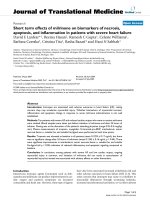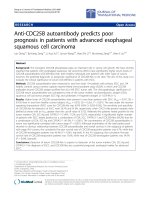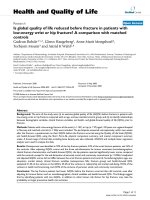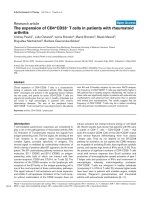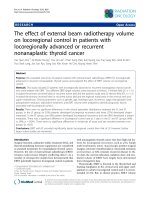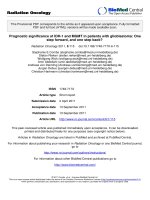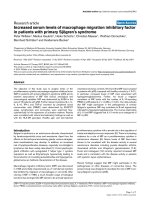Upregulation of MicroRNA-19b predicts good prognosis in patients with hepatocellular carcinoma presenting with vascular invasion or multifocal disease
Bạn đang xem bản rút gọn của tài liệu. Xem và tải ngay bản đầy đủ của tài liệu tại đây (634.1 KB, 10 trang )
Hung et al. BMC Cancer (2015) 15:665
DOI 10.1186/s12885-015-1671-5
RESEARCH ARTICLE
Open Access
Upregulation of MicroRNA-19b predicts good
prognosis in patients with hepatocellular
carcinoma presenting with vascular invasion
or multifocal disease
Chung-Lin Hung1, Chia-Shen Yen2, Hung-Wen Tsai3, Yu-Chieh Su4,5 and Chia-Jui Yen6*
Abstract
Background: After surgical resection of hepatocellular carcinoma (HCC), recurrence is common, especially in
patients presenting with vascular invasion or multifocal disease after curative surgery. Consequently, we examined
the expression pattern and prognostic value of miR-19b in samples from these patients.
Methods: We performed a miRNA microarray to detect differential expression of microRNAs (miRNAs) in 5 paired
samples of HCC and non-tumoral adjacent liver tissue and a quantitative real-time polymerase chain reaction (PCR)
analysis to validate the results in 81 paired samples of HCC and adjacent non-tumoral liver tissues. We examined
the associations of miR-19b expression with clinicopathological parameters and survival. MiR-19b was knocked
down in Hep3B and an mRNA microarray was performed to detect the affected genes.
Results: In both the miRNA microarray and real-time PCR, miR-19b was significantly overexpressed in the HCC tumor
compared with adjacent non-tumor liver tissues (P < 0.001). The expression of miR-19b was significantly higher in
patients who were disease-free 2 years after surgery (P < 0.001). High miR-19b expression levels were associated with
higher α-fetoprotein levels (P = 0.017). In the log-rank test, high miR-19b was associated with better disease-free survival
(median survival 37.107 vs. 11.357; P = 0.022). In Cox multivariate analysis, high miR-19b predicted better disease-free
survival and overall survival (hazards ratio [HR] = 0.453, 95 % confidence interval [CI] = 0.245–0.845, P = 0.013; HR = 0.318,
CI = 0.120–0.846, P = 0.022, respectively). N-myc downstream regulated 1 (NDRG1) was downregulated, while epithelial
cell adhesion molecule (EPCAM), hypoxia-inducible factor 1-alpha (HIF1A), high-mobility group protein B2 (HMGB2), and
mitogen activated protein kinase 14 (MAPK14) were upregulated when miR-19b was knocked down in Hep3B.
Conclusions: The overexpression of miR-19b was significantly correlated with better disease-free and overall survival in
patients with HCC presenting with vascular invasion or multifocal disease after curative surgery. MiR-19b may influence
the expression of NDRG1, EPCAM, HMGB2, HIF1A, and MAPK14.
Keywords: Multifocal, Vascular invasion, miR-19b, MAPK14, HIF1A
* Correspondence:
6
Division of Hematology and Oncology, Department of Internal Medicine,
National Cheng Kung University Hospital, College of Medicine, National
Cheng Kung University, 138 Sheng-Li Road, Tainan 704, Taiwan
Full list of author information is available at the end of the article
© 2015 Hung et al. Open Access This article is distributed under the terms of the Creative Commons Attribution 4.0
International License ( which permits unrestricted use, distribution, and
reproduction in any medium, provided you give appropriate credit to the original author(s) and the source, provide a link to
the Creative Commons license, and indicate if changes were made. The Creative Commons Public Domain Dedication waiver
( applies to the data made available in this article, unless otherwise stated.
Hung et al. BMC Cancer (2015) 15:665
Background
Hepatocellular carcinoma (HCC) is the sixth most prevalent cancer worldwide, and the third most common cause
of cancer-related deaths [1]. In eastern Asian countries,
including Taiwan, chronic infection with hepatitis B virus
(HBV) is the dominant risk factor [2, 3]. Among treatment
options, surgical resection of the tumor remains one of
the most effective ways to cure HCC. Traditionally, patients with clinical Barcelona-Clinic Liver Cancer (BCLC)
stage A disease are candidates for surgery. However,
several reports have shown that curative surgery provides benefits even in patients with vascular invasion
or multifocal diseases [4, 5]. Recurrence remains the
main cause of treatment failure, with recurrence rates
up to 70 % within 5 years after surgery [6]. Risk stratification of patients receiving surgery and identification
of high-risk groups are major challenges. Prognostic
factors focusing on this group of patients have been
limited.
MicroRNAs (miRNAs) are small, non-coding RNAs
composed of ~21 nucleotides. They are transcribed as
precursors in the nucleus and are subsequently processed
into mature miRNAs in the cytoplasm. Mature miRNAs
bind to the 3′-untranslated region of target messenger
RNAs (mRNAs), resulting in translational suppression or
degradation of the mRNAs [7]. The role of miRNAs in
cancer has often been discussed. Several miRNAs, including miR-21, are known to be oncogenic, while the let-7
family has been revealed as a tumor suppressor [8, 9]. A
growing amount of evidence has suggested that miRNAs
play important roles as prognostic and predictive biomarkers in cancers. MiR-21-5p, miR-20a-5p, miR-103a-3p,
miR-106b-5p, miR-143-5p, and miR-215 could stratify risk
groups among stage II colon cancer patients [10]. MiR1290, miR-196b, and miR-135a* have been shown to
predict the chemotherapy response patients with lung
adenocarcinoma [11]. Several miRNAs have also been
reported to correlate with the disease severity and
prognosis of HCC, including miR-15b, miR-122 and
miR-29 [12–14].
MiR-19b is a member of the miR-17-92 cluster. In the
literature, miR-19b has been shown to play a role in the
aging process and thrombosis, as well as cardiovascular
diseases [15–18], and is deregulated in several cancers,
including breast cancer, lung cancer, glioma, and cervical
cancer [19–22]. Some reports have suggested that miR-19b
is upregulated in cancer cells and promotes proliferation
and chemoresistance, while others revealed its ability to
suppress angiogenesis and migration [23–25]. The role of
miR-19b in HCC has not been elucidated.
In the present study, we investigated the feasibility of
miR-19b as a novel prognostic factor for hepatitis B
virus (HBV)-associated HCC with multifocal disease or
vascular invasion after curative surgery.
Page 2 of 10
Methods
Patients and tissue samples
We retrospectively investigated 81 patients diagnosed with
HCC and HBV who had either BCLC stage B or stage C
disease without extrahepatic metastases who received curative surgery between June 2007 and October 2013 at National Cheng Kung University Hospital. For each case, the
diagnosis, histologic grade, and presence of liver cirrhosis
were confirmed by pathologists. HBV infection was diagnosed by the presence of serum HBV surface antigen.
None of these patients had received chemotherapy or
radiotherapy before surgery. Snap-fresh HCC tissues
and paired adjacent non-tumorous liver tissues were
obtained from each patient during surgery. Tissues were
stored in liquid nitrogen after surgical resection until use.
HCC tissues were collected from surgical resected samples
presenting with tumorous features macroscopically. Adjacent non-tumor tissues were collected > 2 cm away from
the edge of the tumors. Clinical parameters including the
serum α-fetoprotein (AFP) level at diagnosis, age, TNM
stage, and gender were obtained from the database of
National Cheng Kung University Hospital Cancer Center.
An abdominal computed tomography scan or magnetic
resonance imaging was performed every 3 to 4 months
after surgery to detect recurrence. The present study was
approved by the Institutional Review Board of National
Cheng Kung University Hospital (ER-99-251). Written informed consent was obtained from all patients. All specimens were handled anonymously according to legal and
ethical regulations, and in accordance with the Helsinki
Declaration of 1975, as revised in 1983. The clinicopathological features of the patients are summarized in Table 1
and Additional file 1: Table S1.
Isolation of total RNA
Total RNA was isolated from frozen samples using miRNA
isolation kits (Qiagen®, Germantown, MD, USA) according
to the manufacturer’s protocol. Briefly, around 30 mg of
snap-fresh tissue of HCC or adjacent non-tumorous liver
were disrupted and homogenized. The lysate was then
centrifuged and the supernatant was transferred to the
gDNA Eliminator spin column. After centrifugation,
the flow-through was transferred to the RNeasy spin
column. RNA was extracted using the buffers RPE and
RW1. The gDNA Eliminator spin columns, RNeasy spin
column and buffers were all supplied in the Qiagen miRNA
isolation kits. The concentration and quality of total RNA
were measured by NanoDrop ND-1000 (NanoDrop Technologies, Wilmington, DE, USA) at 260 and 280 nm
(A260/280) and confirmed by gel electrophoresis.
Human sample microRNA microarray
We selected 5 patients with HBV-associated HCC and
performed a miRNA microarray. Two of these patients
Hung et al. BMC Cancer (2015) 15:665
Page 3 of 10
Table 1 Correlation of miR-19b expression with clinicopathological features of hepatocellular carcinoma
miR-19b expression
Number of cases
High
Low
P
> 60
33(40.7)
16(40)
17(41.5)
0.893
< 60
48(59.3)
24(60)
24(58.5)
Male
55(67.9)
25(62.5)
30(73.2)
Female
26(32.1)
15(37.5)
11(26.8)
II
58(71.6)
31(77.5)
27(65.9)
III + IV
23(28.4)
9(22.5)
14(34.1)
Yes
26(32.1)
15(37.5)
11(26.8)
No
55(67.9)
25(62.5)
30(73.2)
Presence
62(76.5)
29(72.5)
33(80.5)
Absence
19(23.5)
11(27.5)
8(19.5)
> 20
48(59.3)
29(72.5)
19(46.3)
< 20
33(40.7)
11(27.5)
22(53.7)
Clinicopathological variables
Age
Gender
0.304
TNM stage
0.245
Liver cirrhosis
0.304
Vascular invasiona
0.369
AFP (ng/ml)
0.017
Tumor differentiation
W+M
66(81.5)
32(80)
34(82.9)
P
15(18.5)
8(20)
7(17.1)
Solitary
58(71.6)
30(75)
28(68.3)
Multiple
23(28.4)
10(25)
13(31.7)
0.735
Tumor number
0.503
AFP, α-fetoprotein, W well differentiated, M moderate differentiated, P Poorly differentiated, BCLC Barcelona Clinic Liver Cancer
a
Presence of vascular invasion represented BCLC stage C; absence of vascular invasion represented BCLC stage B
had liver cirrhosis. RNA labeling and hybridization were
completed using a kit from Welgene Biotech Co., Ltd
(Welgene Biotech Co., Ltd., Taipei, Taiwan, R.O.C) according to the manufacturer’s instructions. Briefly, RNA
was extracted using miRNA isolation kits (Qiagen®) according to the manufacturer’s protocol. RNA purified
was quantified at OD 260 nm by an ND-1000 spectrophotometer (NanoDrop Technologies) and analyzed by
the Bioanalyzer 2100 (Agilent Technologies, Santa Clara,
CA, USA) with the RNA 6000 Nano LabChip kit. During the in vitro transcription process, 1 μg of total RNA
was amplified by a low RNA input fluor linear amp kit
(Agilent) and labeled with Cy3 (CyDye, PerkinElmer,
Waltham, MA, USA). Using incubation with fragmentation buffer at 60 °C for 30 min, 1.65 μg of Cy3-labled cRNA
was fragmented to an average size of about 50–100 nucleotides. Correspondingly fragmented labeled cRNA was then
pooled and hybridized to SurePrint G3 ChIP/CH3 1X1M
array (Agilent) at 60 °C for 17 h. After washing and drying
by nitrogen gun blowing, the microarrays were scanned
with an Agilent microarray scanner at 535 nm for Cy3.
Scanned images were analyzed by Agilent Feature Extraction, version 10.5. Image analysis and normalization software were used to quantify the signal and background
intensity for each feature. The data have been deposited in NCBI’s Gene Expression Omnibus and are accessible through GEO Series accession no. GSE69580.
Cell line mRNA microarray
RNA labeling and hybridization were completed using a
kit from Phalanx Biotech Co., Ltd. (Phalanx Biotech Group,
Inc., Hsinchu City, Taiwan, R.O.C) according to the manufacturer’s instructions. Briefly, RNA was extracted
after miR-19b knockdown in Hep3B. Purified RNA
was labeled with fluorescein and hybridized on Human
OneArray® (Phalanx Biotech) with 29187 mature human mRNA probes. Finally, hybridization signals were
detected, and the images were scanned and quantified.
Hung et al. BMC Cancer (2015) 15:665
The data have been deposited in NCBI’s Gene Expression
Omnibus and are accessible through GEO Series accession number GSE69519.
Real time qRT-PCR analysis for miRNA expression
Complementary DNA was synthetized from the total
RNA using gene-specific primers of the TaqMan MicroRNA Reverse Transcription Kit (Applied Biosystems®,
Foster City, CA). For real time quantitative reverse transcription polymerase chain reaction (qRT-PCR), primers
for miR-19b and endogenous control U6 were purchased
from Applied Biosystems. All reactions were carried out
in triplicate according to the manufacturer’s protocol.
Briefly, we used 10 ng of RNA sample, 50 nmol/l of
stem-loop reverse transcriptase (RT) primer, 10X RT
buffer, 0.25 mmol/l each of deoxynucleotide triphosphates (dNTPs), 3.33 U/μl MultiScribe RT, and 0.25
U/μl RNase inhibitor (all from Applied Biosystems’
TaqMan MicroRNA Reverse Transcription Kit®). Reaction mixtures (15 μl) were incubated for 30 min at
16 °C, 30 min at 42 °C, and 5 min at 85 °C and then
held at 4 °C (2720 Thermal Cycler; Applied Biosystems®).
Real-time PCR was performed using the StepOne™ Plus
Real-Time PCR System (Applied Biosystems®). The 20 μl
PCR reaction mixture included 1.33 μl of RT product, 1X
TaqMan Universal PCR Master Mix, and 1 μl of primer
and probe mix from the TaqMan MicroRNA Assay Kit
(Applied Biosystems®). Reactions were incubated in a 96well optical plate at 95 °C for 10 min, followed by 40 cycles
at 95 °C for 15 s and 60 °C for 60 s. Relative quantification
of the miR-19b expression was evaluated using the comparative cycle threshold method. The raw data were presented as the relative quantity of miR-19b, normalized
with respect to U6.
Page 4 of 10
TaqMan® Reverse Transcription Kit). Reaction mixtures
(20 μl) were incubated for 10 min at 25 °C, 30 min
at 37 °C, and 5 min at 95 °C and then held at 4 °C
(2720 Thermal Cycler; Applied Biosystems®). Real-time
PCR was performed using the StepOne™ Plus Real-Time
PCR System (Applied Biosystems®). The 10 μl PCR reaction
mixture included 1 μl of RT product, 5 μl of 2X TaqMan
Universal PCR Master Mix, and 0.5 μl of primer and probe
mix from the TaqMan Gene expression Assay Kit (Applied
Biosystems®). Reactions were incubated in a 96-well optical
plate at 95 °C for 10 min, followed by 40 cycles at 95 °C
for 15 s and 60 °C for 60 s. Relative quantification of
the miR-19b expression was evaluated using the comparative cycle threshold method. The raw data were
presented as the relative quantity of NDRG1, EPCAM,
HIF1A, HMGB2 and MAPK14, normalized with respect to GAPDH.
Cell line culture
Human HCC cell line Hep 3B was obtained from American
Type Culture Collection (ATCC®, Manassas, VA, USA), was
validated in 2014, and was cultured in MEM medium
(Invitrogen, Carlsbad, CA,USA) plus 10 % newborn calf
serum. Ethics approval was not required.
Transfection
A quantity of approximately 2 × 105 Hep 3B cells were
seeded and cultured in 6-well plates. For each well, 90 pmol
of miR-19b inhibitor or control were added to 300 μL
Opti-MEM medium and 10 μL of Lipofectamine® 2000 (all
Applied Biosystems®). The mixture was added to the cells
and incubated for 6 h before replacing the medium. Cells
were collected for RNA extraction 24 h after transfection.
Statistical analysis
Real time qRT-PCR analysis for mRNA expression
Complementary DNA was synthetized from the total
RNA using gene-specific primers of the TaqMan® Reverse
Transcription Kit (Applied Biosystems®, Foster City, CA,
USA). For real time qRT-PCR, primers for N-myc downstream regulated 1 (NDRG1), epithelial cell adhesion molecule (EPCAM), hypoxia-inducible factor 1-alpha (HIF1A),
high-mobility group protein B2 (HMGB2) and mitogen activated protein kinase 14 (MAPK14) and endogenous control glyceraldehyde 3-phosphate dehydrogenase (GAPDH)
were purchased from Applied Biosystems. All reactions
were carried out in triplicate according to the manufacturer’s protocol. Briefly, we used 1 ng of RNA sample, 1 μl
random primer (random hexamer at a concentration of
0.5 μM as primer, 10X RT buffer, 2.5 mM each of dNTPs,
1 μl of MultiScribe RT™ at a concentration of 50 U/μl,
1.4 μl of 25 mM MgCl2 and 1 μl of RNase inhibitor at a
concentration of 20 U/μl (all from Applied Biosystems’
The Mann–Whitney test was performed to determine
the significance of miRNA levels between the HCC tumor
and non-tumor adjacent tissues. Student’s t-test was performed to determine the significance of the AFP level between different groups of patients. Group comparisons of
categorical variables were evaluated using the χ2 test.
Overall survival (OS) was defined from the date of diagnosis to the date of death. Correlation of variables was analyzed using Pearson correlation coefficient. Disease free
survival (DFS) was defined from the date of surgery to the
date of recurrence. Survival curves were plotted using the
Kaplan–Meier method and differences in survival rates
were analyzed using the log-rank test. The prognostic relevance of each variable to OS and DFS were analyzed using
the Cox regression model. Multivariate analysis of the
prognostic factors was performed using the Cox regression model. A P-value less than 0.05 was considered
statistically significant. All statistical calculations were
Hung et al. BMC Cancer (2015) 15:665
performed using SPSS 18.0 for Windows (SPSS Inc.,
Chicago, IL, USA).
Results
Overexpression of miR-19b in hepatocellular carcinoma
We first performed a miRNA microarray for 5 selected
paired HCC and adjacent non-tumoral liver tissue
samples. As shown in Fig. 1a and Additional file 1:
Table S2, we found that miR-19b was up-regulated in
all five samples. MiR-21, miR-17, miR-20a, and miR-106b
were also overexpressed, whereas let-7b and let-7c were
downregulated in HCC tumor samples. To validate these
results, we then evaluated miR-19b expression by qRT-PCR
Page 5 of 10
analysis in 81 paired samples of tumor and adjacent nontumorous tissues diagnosed with HCC. The results are
shown in Fig. 1b. The expression levels of miR-19b in
the HCC tumorous tissues (median expression level 0.7184,
range 0.0192 to 21.104) were significantly higher than those
in the adjacent non-tumorous liver tissues (median expression level 0.3246, range 0.0169 to 6.667, P < 0.001). We also
found that the expression level of miR-19b was significantly
higher in patients who were disease-free for at least
two years after surgery (n = 36, median expression level
1.1109, range 0.0192 to 21.104), compared with those
whose cancer recurred within two years (n = 45, median 0.4988, range 0.1123 to 7.997, P < 0.001, Fig. 2.).
Fig. 1 a MiRNAs are deregulated in hepatocellular carcinoma as detected by miRNA microarray. Five pairs of hepatocellular carcinoma and
adjacent non-tumor liver tissue matches were analyzed using SurePrint G3 ChIP/CH3 1X1M array (Agilent Technologies, Santa Clara, CA, USA).
Rows: miRNAs; columns: cases. For each miRNA, red represents higher expression and green represents lower expression than the corresponding
adjacent non-tumoral liver tissue expression. S1, sample 1; S2, sample 2; S3, sample 3; S4, sample 4; S5, sample 5. b MiR-19b is overexpressed in
the HCC tissues compared with normal adjacent liver tissue (median expression level 0.3246, range 0.0169 to 6.667, P < 0.001, Mann–Whitney test).
miR-19b, microRNA-19b. HCC, hepatocellular carcinoma
Hung et al. BMC Cancer (2015) 15:665
Fig. 2 MiR-19b in HCC is overexpressed in patients with no recurrence
(n = 36, median expression level 1.1109, range 0.0192 to 21.104)
compared with those whose cancer recurred within 2 years (n = 45,
median 0.4988, range 0.1123 to 7.997), P < 0.001, Mann–Whitney test.
miR-19b, microRNA-19b. HCC, hepatocellular carcinoma
Page 6 of 10
Fig. 3 Correlation between miR-19b expression and disease-free
survival rates in 81 patients with HCC after curative surgery. Patients
with high levels of miR-19b had significantly better disease-free survival
than those with low levels (median survival 37.107 vs.11.357; P = 0.022,
Log-rank test. Kaplan–Meier survival curves for disease-free survival are
plotted according to miR-19b expression. miR-19b, microRNA-19b. HCC,
hepatocellular carcinoma
Association of miR-19b with the clinicopathological features
of HCC
The median expression value of miR-19b was used as a
cut-off. HCC tissue samples expressing miR-19b at levels
lower than the median expression level were assigned to
the low-expression group (n = 41) and samples with
expression above the median value were assigned to
the high-expression group (n = 40). The relationships of
miR-19b with various clinicopathological features of HCC
were analyzed and are summarized in Table 1. The results
revealed that a high level of miR-19b expression was correlated with an elevated AFP level (P = 0.017). However, there
were no significant correlations of miR-19b expression with
other clinical features such as gender, age, vascular invasion,
TNM stage, liver cirrhosis, tumor differentiation or number
of tumors (all P > 0.05). There was no significant difference
in the serum AFP levels between the miR-19b lowexpression and high-expression groups (Student’s t-test,
P = 0.408). There was no correlation between the miR-19b
expression level and serum AFP level (Pearson correlation
coefficient, r = −0.032, p = 0.778).
Mir-19b expression predicts better survival in patients
with HCC
We further investigated the correlation between the
miR-19b expression level and the survival of patients
with HBV-associated HCC. As shown in Fig. 3, the
DFS of the high miR-19b expression group was significantly longer than that of the low miR-19b expression
group (median survival 37.107 vs.11.357; P = 0.022). In
multivariate analysis, miR-19b expression was an independent good prognostic factor for both DFS (hazards
ratio [HR] = 0.453, 95 % confidence interval [CI] = 0.245–
0.845, P = 0.013, Table 2) and OS (HR = 0.318, CI =0.120–
0.846, P = 0.022, Table 2) in patients with more advanced
HBV-associated HCC.
Potential targets of miR-19b
In order to evaluate how miR-19b exerts its effect on
DFS and recurrence, we knocked down the expression
of miR-19b in Hep3B cells, extracted the RNA, and performed an mRNA microarray using the RNA. We then
selected genes that were either upregulated or downregulated more that 1.5 times as our candidates. In total, 71
genes were upregulated as miR-19b was knocked down,
and 32 genes were downregulated after miR-19b was suppressed (Additional file 1: Table S3 and S4). Among them,
genes such as NDRG1 were downregulated when miR-19b
was suppressed, whereas EPCAM, HIF1A, HMGB2, and
MAPK14 were upregulated. The reported functions of
these genes and references are illustrated in Table 3.
Then, we tested the expression level of NDRG1, EPCAM,
HIF1A, HMGB2 and MAPK 14 in 20 HCC tumor samples
from the aforementioned patient cohort, and analyzed the
correlation between the expression level of these genes and
miR-19b. The results are shown in Additional file 1: Table
S5 and Additional files 1 and 2. There was a trend toward
negative correlation between the expression of miR-19b
and HIF1A and MAPK 14 in our HCC samples (Pearson’s
correlation, r = −0.219 and −0.229, P = 0.352 and 0.332,
respectively).
Discussion
Currently, surgery remains one of the most effective ways
to cure HCC. Traditionally, surgical resection is only recommended for patients with BCLC stage A disease. With
the improvements in surgical technique and careful patient

